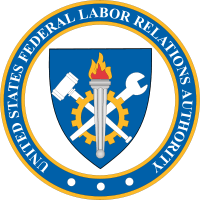Federal Labor Relations Authority
| FLRA | |
 | |
| Agency overview | |
|---|---|
| Formed | 1978 |
| Jurisdiction | Federal government of the United States |
| Headquarters | Washington, D.C. |
| Agency executive |
|
| Website | Federal Labor Relations Authority |
The Federal Labor Relations Authority (FLRA) is an independent agency of the United States government that governs labor relations between the federal government and its employees.
Created by the Civil Service Reform Act of 1978, it is a quasi-judicial body with three full-time members who are appointed for five-year terms by the President with the advice and consent of the Senate. One member is appointed by the President to serve as chairman, chief executive officer, and chief administrative officer of the FLRA. The chairman is also ex officio chairman of the Foreign Service Labor Relations Board.
The Authority adjudicates disputes arising under the Civil Service Reform Act, deciding cases concerning the negotiability of collective bargaining agreement proposals, appeals concerning unfair labor practices and representation petitions, and exceptions to grievance arbitration awards. Consistent with its statutory charge to provide leadership in establishing policies and guidance to participants in the Federal labor-management relations program, the Authority also assists Federal agencies and unions in understanding their rights and responsibilities under the Statute through statutory training of parties.
In 1981 it decertified, that is stripped it from its status as a representative union, the air traffic controllers PATCO union, after the 1981 air traffic controllers strike.[1]
The agency is separate from the National Labor Relations Board, which governs private-sector labor relations.
See also
- Title 5 of the Code of Federal Regulations
- Title 22 of the Code of Federal Regulations
- National Labor Relations Board
- Federal Mediation and Conciliation Service (United States)
- United States Merit Systems Protection Board
References
External links
- Federal Labor Relations Authority
- Federal Labor Relations Authority in the Federal Register
- FLRA Mission and Functions
![]() This article incorporates public domain material from the United States Government document "http://www.flra.gov".
This article incorporates public domain material from the United States Government document "http://www.flra.gov".